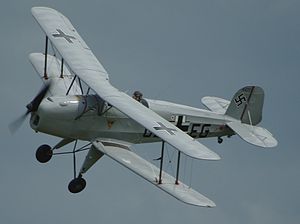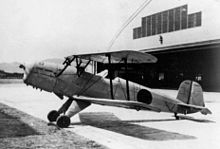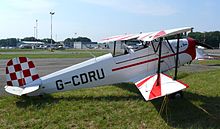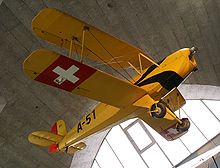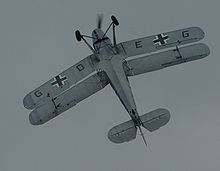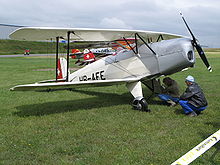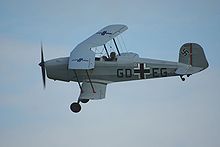- Bücker Bü 131
-
Bü 131 "Jungmann" Role Basic trainer Manufacturer Bücker Flugzeugbau Designer Carl Bücker First flight 27 April 1934 Introduction 1935 (Luftwaffe) Retired 1968 (Spanish Air Force) Primary users Luftwaffe
Spanish Air Force
Imperial Japanese Army Air ServiceVariants Bü 133 Jungmeister The German Bücker Bü 131 "Jungmann" (Young man) was a 1930s basic training aircraft which was used by the Luftwaffe during World War II.
Contents
Development
After serving in the Kaiserliche Marine in World War I, Carl Bücker moved to Sweden where he became managing director of Svenska Aero AB (Not to be confused with Svenska Aeroplan AB, SAAB). He later returned to Germany with Anders J Andersson, a young designer from SAAB. Bücker Flugzeugbau GmbH was founded in Berlin-Johannistahl,[1] in 1932, with the first aircraft to see production being the Bü 131 Jungmann.
Bücker Flugzeugbau's first production type,[1] the Bü 131A was the last biplane built in Germany.[1] It had two open cockpits in tandem and fixed landing gear.[1] The fuselage was steel tube, covered in fabric and metal,[1] the wings wood and fabric.[1] It first flew on the 80 hp (60 kW) Hirth HM60R.[1]
In 1936, it was followed by the Bü 131B, with a 105 hp (78 kW) Hirth 504A-2.[1]
Most wartime production for the Luftwaffe was by Aero in Prague.[1]
Operational history
Sturdy and agile, the Bü 131A was first delivered to the Deutscher Luftsportverband (DLV).[1] The Bü 131B was selected as the primary basic trainer for the German Luftwaffe,[1] and it served with "virtually all" the Luftwaffe's primary flying schools during the war, as well as with night harassment units such as Nachtschlacht Gruppen (NSGr) 2, 11, and 12.[1] Yugoslavia was the main prewar export customer; "as many as 400 may have found their way" there.[1] She was joined by Bulgaria with 15 and Rumania with 40.[1]
Production licenses were granted to Switzerland (using 94, 88 built under licence to Dornier),[1] Spain (building about 530),[1] Hungary (which operated 315),[1] Czechoslovakia (10, as the Tatra T 131, before war began),[1] and Japan, the last of which built 1,037 for Army with Hatsukaze power as the Kokusai Ki-86[1] and 339 for the Navy Air Services as the Kyushu K9W.[1] In Spain, production continued at CASA until the early 1960s. The Jungmann was retained as the Spanish Air Force's primary basic trainer until 1968.
About 200 Jungmanns survive to this day, many having been fitted with modern engines. In 1994, the Bü 131 was restored to production briefly using CASA jigs by Bücker Prado in Spain, with 21 aircraft constructed as the BP 131,[1] while SSH Janusz Karasiewicz in Poland also started production of a version of the Jungmann based on Czech plans in 1994.[2]
Variants
- Bü 131A : Two-seat primary trainer biplane. Initial production version.
- Bü 131B : Improved version, powered by the more powerful Hirth HM 504A-2 piston engine.
- Bü 131C : Experimental version, fitted with 67 kW (90 hp) Cirrus Minor piston engine. One built.
- Ki-86A : Japanese production version for the Imperial Japanese Army Air Service.
- Kyushu K9W1 : Japanese production version for the Imperial Japanese Navy.
- Tatra T.131 : Czechoslovakia, pre-war licence production in Tatra Koprivnice.
- Aero C-4 : Mass-produced in Aero factory in occupied Czechoslovakia during wartime under original Bücker Bü 131B designation, used postwar with original Hirth engine.
- Aero C-104 : Czechoslovakia, postwar development with a Walter Minor 4-III engine, 260 aircraft built.
- CASA 1.131 : Spanish license-built versions
- BP 131 : modern license-built version
- SSH T-131P : Pre-production modern Polish version, powered by 78 kW (105 hp) Walter Minor 4-III engine. Four built from 1994.[2]
- SSH T-131PA :Main Polish production version, with 103 kW (138 hp) LOM M332AK engine. First flew 1995.[2]
Operators
- Czechoslovak Air Force operated this type post war.
- Royal Hungarian Air Force
- Imperial Japanese Army Air Service operated this type as Kokusai Ki-86.
- Imperial Japanese Navy Air Service operated this type as Kyushu K9W1.
- Swiss Air Force operated this type from 1936 to 1971.
Specifications (Bü 131B)
Data from Jane's Fighting Aircraft of World War II[3]
General characteristics
- Crew: Two (student and instructor)
- Length: 6.62 m (21 ft 8 in)
- Wingspan: 7.40 m (24 ft 3 in)
- Height: 2.35 m (7 ft 6 in)
- Wing area: 13.5 m² (145 ft²)
- Empty weight: 380 kg (840 lb)
- Loaded weight: 670 kg (1,500 lb)
- Powerplant: 1 × Hirth HM 504 four-cylinder inverted inline engine, 70 kW (100 hp)
Performance
- Maximum speed: 183 km/h (99 kn, 115 mph)
- Cruise speed: 170 km/h (92 kn, 110 mph)
- Range: 628 km (339 nm, 390 mi)
- Service ceiling: 4,050 m (13,300 ft)
- Rate of climb: 2.8 m/s (6,600 ft)
- Wing loading: 46.3 kg/m² (9.49 lb/ft²)
- Power/mass: 100 W/kg (0.064 hp/lb)
See also
- Related development
- Aircraft of comparable role, configuration and era
- Boeing-Stearman Kaydet
- de Havilland Tiger Moth
- Fisher Youngster
- Fleet Finch
- Stampe SV.4
- Polikarpov Po-2
- Leopoldoff L.55 Colibri
- Related lists
References
- Notes
- Bibliography
- Bridgeman, Leonard. “The Bücker Bü 131B “Jungmann”.” Jane's Fighting Aircraft of World War II. London: Studio, 1946. ISBN 1-85170-493-0.
- Jackson, Paul. Jane's All The World's Aircraft 2003–2004. Coulsdon, UK: Jane's Information Group, 2003. ISBN 0-7106-2537-5.
- Ketley, Barry, and Mark Rolfe. Luftwaffe Fledglings 1935-1945: Luftwaffe Training Units and their Aircraft. Aldershot, GB: Hikoki Publications, 1996. ISBN 0-951-9899-2-8.
- König, Erwin. Bücker Bü 131 "Jungmann"(Flugzeug Profile 27) (in German). D-86669 Stengelheim, Germany: Unitec Medienvertrieb e.K.,
- König, Erwin. Die Bücker-Flugzeuge (The Bücker Aircraft) (bilingual German/English). Martinsried, Germany: Nara Verlag, 1987. ISBN 3-925671-00-5.
- König, Erwin. Die Bückers, Die Geschichte der ehemaligen Bücker-Flugzeugbau-GmbH und ihrer Flugzeuge (in German). (1979)
- Mondey, David. The Hamlyn Concise Guide to Axis Aircraft of World War II. London: Chancellor Press Ltd, 2006. ISBN 1-85152-966-7.
- Sarjeant, L.F. Bücker Bü 131 Jungmann (Aircraft in Profile 222). Windsor, Berkshire, UK: Profile Publications Ltd., 1971.
- Smith, J. Richard and Antony L. Kay. German Aircraft of the Second World War. London: Putnam and Company Ltd., 3rd impression 1978, pp. 91–92. ISBN 0-370-00024-2.
- Wietstruk, Siegfried. Bücker-Flugzeugbau, Die Geschichte eines Flugzeugwerkes (in German). D-82041 Oberhaching, Germany: Aviatik Verlag, 1999. ISBN 3-925505-28-8.
- Wood, Tony and Bill Gunston. Hitler's Luftwaffe: A Pictorial History and Technical Encyclopedia of Hitler's Air Power in World War II. London: Salamander Books Ltd., 1977, p. 139. ISBN 0-86101-005-1.
External links
Bücker Flugzeugbau aircraft Aircraft by RLM designation: Aircraft by name: Bestmann • Jungmann • Jungmeister • Kornett • Student
Construcciones Aeronáuticas SA (CASA) and EADS CASA aircraft Fixed-wing aircraft Aircraft produced by Watanabe and Kyushu Watanabe Ironworks Kyushu Aircraft Company Allied reporting names Cypress • Lorna • Oak
Reich Air Ministry aircraft designations 1 to 100 B 9 · Gö 9 · Do 10 · Do 11 · Wn 11 · Do 12 · Do 13 · Do 14 · Do 15 · Wn 15 · Do 16 · Wn 16 · Do 17 · Do 18 · Do 19 · Do 20 · Do 22 · Do 23 · Do 24 · Kl 25 · Do 26 · Kl 26 · M 27 · Do 29 · Kl 31 · Kl 32 · W 33 · L 33 · W 34 · Kl 35 · Kl 36 · HD 37 · HD 38 · G 38 · DFS 39 · BV 40 · DFS 40 · A 40 · Fw 42 · He 42 · A 43 · HD 43 · Fw 44 · He 45 · He 46 · Ju 46 · Fw 47 · He 47 · K 47 · A 48 · He 49 · Ju 49 · He 50 · A 50 · He 51 · K 51 · Ju 52 · K 53 · NR 54 · Fw 55 · NR 55 · Fw 56 · Fw 57 · Fw 58 · He 58 · He 59 · He 60 · Ju 60 · Fw 61 · He 61 · Fw 62 · He 62 · He 63 · Ar 64 · He 64 · Ar 65 · He 65 · Ar 66 · He 66 · Ar 67 · Ar 68 · Ar 69 · He 70 · He 71 · He 72 · He 74 · Ar 76 · Ar 77 · Ar 79 · Ar 80 · Ar 81 · Ju 85 · Ju 86 · Ju 87 · Ju 88 · Ju 89 · Ju 90 · Ar 95 · Ar 96 · Fi 97 · Fi 98 · Fi 99 · He 100
101 to 200 Al 101 · Al 102 · Al 103 · Fi 103 · Fh 104 · Kl 105 · Kl 106 · Kl 107 · Bf 108 · Bf 109 · Bf 110 · He 111 · He 112 · He 113 · He 114 · He 115 · He 116 · Hs 117 · He 118 · He 119 · He 120 · Hs 121 · Hs 122 · Hs 123 · Hs 124 · Hs 125 · Hs 126 · Hs 127 · Hs 128 · Hs 129 · Hs 130 · Bü 131 · Hs 132 · Bü 133 · Bü 134 · Ha 135 · Ha 136 · Hü 136 · Ha 137 · BV 138 · Ha 139 · Ha 140 · BV 141 · BV 142 · BV 143 · BV 144 · Go 145 · Go 146 · Go 147 · Ju 147 · Go 149 · Go 150 · Kl 151 · Ta 152 · Kl 152 · Ta 153 · Ta 154 · BV 155 · Fi 156 · Fi 157 · Fi 158 · Fw 159 · Ju 160 · Bf 161 · He 162 · Bf 162 · Bf 163 · Me 163 · Me 164 · Fi 166 · FK 166 · Fi 167 · Fi 168 · He 170 · He 172 · He 176 · He 177 · He 178 · Bü 180 · Bü 181 · Bü 182 · Ta 183 · Fl 184 · Fl 185 · Fw 186 · Ju 186 · Fw 187 · Ju 187 · Ju 188 · Fw 189 · Fw 190 · Fw 191 · Ao 192 · DFS 193 · DFS 194 · Ar 195 · Ar 196 · Ar 197 · Ar 198 · Ar 199 · Fw 200
201 to 300 Si 201 · Si 202 · DFS 203 · Si 204 · Fw 206 · Me 208 · Me 209 · Me 209-II · Me 210 · Hü 211 · Do 212 · Do 214 · Do 215 · Do 216 · Do 217 · Hs 217 · He 219 · He 220 · BV 222 · Fa 223 · Fa 224 · Ao 225 · Fa 225 · BV 226 · Ho 226 · Fg 227 · DFS 228 · Ho 229 · DFS 230 · Ar 231 · Ar 232 · Ar 233 · Ar 234 · Do 235 · BV 237 · BV 238 · Fw 238 · Ar 239 · Ar 240 · Go 241 · Go 242 · Go 244 · BV 246 · Ju 248 · BV 250 · Fw 250 · Ho 250 · Ho 251 · Ho 252 · Ju 252 · Fi 253 · Ho 253 · Ta 254 · Ho 254 · Fi 256 · Sk 257 · Fw 261 · Me 261 · Me 262 · Me 263 · Me 264 · Fl 265 · Me 265 · Fa 266 · Ho 267 · Ju 268 · Fa 269 · He 270 · We 271 · Fw 272 · He 274 · He 275 · He 277 · He 278 · He 280 · Fl 282 · Fa 283 · Ta 283 · Fa 284 · Fl 285 · Ju 286 · Ju 287 · Ju 288 · Ju 290 · Me 290 · As 292 · Hs 293 · Hs 294 · Hs 295 · Ar 296 · Hs 296 · Hs 297 · Hs 298 · Fw 300
301- Me 309 · Me 310 · Do 317 · Do 318 · He 319 · Me 321 · Ju 322 · Me 323 · Me 328 · Me 329 · Fa 330 · DFS 331 · DFS 332 · Fi 333 · Me 334 · Do 335 · Fa 336 · Fl 339 · Ar 340 · Wn 342 · He 343 · Rk 344 · So 344 · Go 345 · DFS 346 · Rk 347 · Ba 349 · Ju 352 · Me 362 · Me 364 · Ju 388 · Ju 390 · Fw 391 · Ar 396 · Ta 400 · Me 409 · Me 410 · Do 417 · He 419 · ZMe 423 · Ar 430 · Ka 430 · Ar 432 · Do 435 · Ar 440 · Ju 452 · Me 462 · Ju 488 · Fw 491 · Me 509 · Me 510 · He 519 · ZSO 523 · Ar 532 · Do 535 · Me 609 · Ar 632 · Do 635
Japanese Navy Trainer Aircraft designations World War II Allied reporting names for Japanese aircraft Aircraft in Japanese service Abdul • Alf • Ann • Babs • Baka • Belle • Betty • Bob • Buzzard • Cedar • Cherry • Clara • Claude • Cypress • Dave • Dick • Dinah • Dot • Edna • Emily • Eva • Eve • Frances • Frank • Gander • George • Glen • Goose • Grace • Gwen • Hamp • Hank • Hap • Helen • Hickory • Ida (Tachikawa Ki-36) • Ida (Tachikawa Ki-55) • Irving • Jack • Jake • Jane • Jean • Jerry • Jill • Jim • Judy • Kate • Kate 61 • Laura • Lily • Liz • Lorna • Loise • Louise • Luke • Mabel • Mary • Mavis • Myrt • Nate • Nell • Nick • Norm • Oak • Oscar • Pat • Patsy • Paul • Peggy • Perry • Pete • Pine • Rex • Rita • Rob • Rufe • Ruth • Sally • Sally III • Sam • Sandy • Slim • Sonia • Spruce • Stella • Steve • Susie • Tabby • Tess • Thalia • Thelma • Theresa • Thora • Tina • Tillie • Toby • Tojo • Tony • Topsy • Val • Willow • Zeke • Zeke 32
Nonexistent aircraft thought to be in Japanese service Adam • Ben • Doris • Gus • Harry • Ione • Joe • Joyce • Julia • June • Norma • Omar • Ray
Foreign aircraft erroneously thought to be in Japanese service Lists relating to aviation General Aircraft (manufacturers) · Aircraft engines (manufacturers) · Airlines (defunct) · Airports · Civil authorities · Museums · Registration prefixes · Rotorcraft (manufacturers) · TimelineMilitary Accidents/incidents Records Categories:- Propeller aircraft
- Biplane aircraft
- Single-engine aircraft
- German military trainer aircraft 1930–1939
Wikimedia Foundation. 2010.

